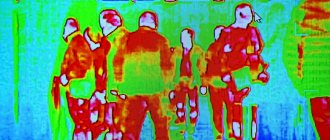Average reading time: 8 minutes
Publication date: August 09, 2021
Zakharova Carolina Yurievna
Physician and author of scientific articles on therapy, ophthalmology, pediatrics and psychiatry
The mark “37” on the thermometer can cause many questions. Should I be worried or is this normal? Or maybe it’s time to take antipyretics? Let's figure out what causes a slight fever and what should be done.
Up to contents
Why does the temperature rise to 37 °C?
Body temperature is not a constant value, it fluctuates during the day within the range of 0.1 -0.6 ° C, in the morning it is usually lower than in the evening1. Therefore, the norm may be within 36-37 °C1.
However, the method of measurement must be taken into account. Typically, body temperature is determined in the armpit, and here its optimal value is considered to be 36.6 °C1. And if you use a rectal thermometer and measure body temperature in the rectum, remember that here it is normally 0.5-1.0 °C higher than under the armpit1.
When the thermometer records a temperature between 37°C and 38°C (when measured in the armpit), this is already a fever1, but since it is not pronounced, it is called subfebrile3.
The term “subfebrile” comes from the words sub – “under, to a weak degree” and febris – “fever”3. Low-grade fever that lasts a long time is called low-grade fever3.
Depending on the severity, subfebrile condition is distinguished2:
- ● low – up to 37.1 °C;
- ● high – up to 38.0 °С2.
Despite the variety of causes, in 70-75% of cases, an increase in temperature to 37-38 ° C is caused by infection2. Infectious agents, such as viruses and bacteria, act as pyrogens4 - substances that rearrange the functioning of the thermoregulation center in the brain (hypothalamus). In this center, two areas are separately distinguished: heat production and heat transfer1,4. Under the influence of pyrogens, the balance of heat production and heat loss is disrupted, which leads to fever1,4.
Up to contents
And yet, what diseases can cause low-grade fever?
An increase in temperature to 37–37.5°C can be a symptom of a number of difficult to diagnose diseases. Here are some of them:
- sluggish local and general inflammatory processes in the body;
- pneumonia (pneumonia);
- chronic tonsillitis (inflammation of the palatine and pharyngeal tonsils);
- hepatitis;
- tuberculosis;
- HIV AIDS;
- chronic pyelonephritis (inflammation of the kidneys);
- dysfunction of the cardiovascular system;
- ulcerative colitis, gastritis (inflammation in the gastrointestinal tract);
- toxoplasmosis, herpes, other TORCH infections;
- allergic reactions;
- malignant tumors (oncology);
- thyrotoxicosis (increased production of thyroid hormones);
- helminthic infestations or the presence of other parasites in the body;
- anemia.
Diagnosing a disease when the only symptom is low-grade fever is difficult. (Editor’s note: in the scientific article “Fever of unknown origin,” a group of medical specialists explains in detail why it is difficult to establish a diagnosis and what studies may be required to determine the cause of an increase in temperature to 37‒37.5 ° C).
Causes of temperature 37 °C without cold symptoms
Sometimes the rise in temperature is not associated with the action of viral and bacterial pyrogens; this condition is called hyperthermia1.
Mild hyperthermia may occur in healthy people1:
- ● during intense physical activity1;
- ● after meals1;
- ● against the background of severe stress (“workday hyperthermia” in adults)3;
- ● in hot weather1 and prolonged exposure to the sun2;
- ● as a side effect of taking certain medications1.
In women, a temperature of 37 °C can occur after ovulation5 and 7-10 days before the onset of menstruation6. This temperature reaction is associated with an increase in the level of the hormone progesterone5.
Pyrogens that are formed in the body itself can also affect the thermoregulation center, which is why low-grade fever often occurs with non-infectious diseases4.
For example, a temperature of 37 °C may be a sign
:
- ● neurogenic hyperthermia4, which is associated with imperfect nervous regulation4,7;
- ● iron deficiency anemia2 (low hemoglobin levels due to iron deficiency);
- ● chronic gastritis, hepatitis and colitis2;
- ● peptic ulcer of the stomach and duodenum2;
- ● urolithiasis and cholelithiasis1;
- ● the presence of foci of inflammation in the body (for example, in the bronchi or genitourinary organs)2;
- ● bronchial asthma2;
- ● autoimmune diseases2;
- ● hormonal imbalance (with menopausal syndrome or increased thyroid function)6;
- ● malignant process2;
- ● diseases of the hypothalamus2.
Up to contents
3. Symptoms and diagnosis
In medicine, there is a stable expression “low-grade fever without signs of a cold.” If there really are no such signs, it is very important to understand and tell the doctor what is unusual in your condition and well-being, what associated symptoms or discomfort are accompanied by persistent low-grade fever. It is impossible to list all the options; their number is almost endless and ranges from intense pain syndromes to a barely noticeable decrease in function. Changes can be found in any system or physiological process of the body - digestion, sensory organs, skin, musculoskeletal system, etc.
In some cases, to reliably establish the causes, it is enough to collect complaints and anamnesis, as well as a standard therapeutic examination with palpation, auscultation and percussion. In others, a thorough multifaceted examination may be required using laboratory tests, instrumental imaging, endoscopic and functional diagnostic methods. However, in the vast majority of cases, given the diagnostic capabilities of modern medicine, the cause is eventually found.
About our clinic Chistye Prudy metro station Medintercom page!
Is it necessary to bring down the temperature of 37 °C in an adult?
Fever itself is a protective reaction of the body8, so antipyretic drugs should be taken only as indicated - for adults at a temperature above 38.5 °C and/or muscle and joint pain due to ARVI12.
For ARVI it is recommended12:
- ● bed rest;
- ● drinking plenty of water;
- ● a diet rich in vitamins;
- ● symptomatic treatment (to relieve nasal congestion, cough and other symptoms of a cold);
- ● taking antiviral drugs.
Anaferon®11 lozenges can be used as part of complex therapy for ARVI. The active ingredient of the drug is antibodies to interferon gamma. Their antiviral and immunomodulatory effects are associated with the activation of natural immune factors that help the body fight viruses11,13. Anaferon ® is indicated for the treatment of influenza and other acute respiratory viral infections11. Its use as part of complex therapy helps reduce the duration of the main symptoms of the disease by 1.5 times or more13. Also, Anaferon ® can be used during the ARVI epidemic season as a prophylactic agent for 3 months11.
Up to contents
When to contact Altimed MC
High temperature for no reason is the main indication for visiting the Altimed medical center. Innovative equipment combined with the high professionalism of doctors will help identify the disorder and develop an optimal treatment regimen.
If a symptom is detected in a child, you cannot hesitate! Get help right away! This action will identify the disorder at the initial stage of development and prevent serious complications.
Temperature 37 °C in children
Many of the causes of hyperthermia in a child are the same as in an adult. For example, children can overheat in the sun in hot weather; their nervous system, which controls the processes of heat production and heat transfer, may also be disrupted3.
In most cases, the child develops a so-called post-infectious low-grade fever, which is associated with a recent acute respiratory viral infection.
In 86% of children, low-grade fever may persist for 3-6 months after viral infection3.
Often a child has a body temperature of 37 °C for no apparent reason. This is the so-called institutional fever or “thermoneurosis”3. With “thermoneurosis,” the child usually tolerates the fever well. Parents may notice that antipyretic drugs do not give the desired effect, and the rise in body temperature is associated with psycho-emotional stress, for example, the stress that the child experiences at school3.
Up to contents
Viral hepatitis B and C
Hepatitis caused by viruses often causes low-grade fever. The onset may be acute or gradual. Symptoms of viral hepatitis, which is sluggish:
- low-grade fever
- weakness in the body and general poor health
- discomfort in the liver area after eating
- active sweating
- slight manifestations of jaundice
- muscle pain
- joint pain
The temperature can rise to low-grade levels if hepatitis occurs in a chronic form, periodically exacerbating. Hepatitis can be “caught” through medical instruments that are not disinfected, unprotected sexual contact, in the dentist’s office and during a manicure, through blood transfusions using non-sterile systems (and if a person has been transfused with the patient’s blood), from a sick mother to the fetus during pregnancy, through dirty syringes.
Is it worth lowering a child’s temperature to 37°C?
Children usually have a higher body temperature than an adult1, so do not rush to give your child antipyretics.
Symptomatic treatment with antipyretic drugs is indicated when8:
- ● body temperature above 39.0 °C in children of any age;
- ● fever above 38 °C in children under 3 months or if the child has severe concomitant diseases, for example, damage to the cardiovascular and nervous systems;
- ● “white” fever, in which the skin becomes cold, pale, and a “marble” pattern appears on it.
In other cases, it is not recommended to reduce a child’s fever. In addition, it should be borne in mind that fever itself activates the immune system in the fight against infection4. For ARVI in children, to support immunity, the doctor may recommend Anaferon ® for children in the form of lozenges or drops for oral administration9,10.
Anaferon ® for children is approved for use in children from 1 month of age as part of complex therapy for ARVI. It stimulates the immune system, promotes the production of antibodies and increases the functional activity of immune cells9,10. Also, Anaferon ® for children can be used for the prevention of ARVI9,10 due to its ability to maintain the child’s body in a state of high readiness for protection against viruses14.
Up to contents
When is an increase in temperature dangerous?
High body temperature is an undoubted sign that some pathological process, usually of an inflammatory nature, is developing in the body. The higher the temperature, the faster it rises or the longer it lasts, the more serious the problem that caused it may be. This is why high temperatures are scary.
Meanwhile, in itself, an increase in temperature in most cases is a protective reaction to the penetration of infection. At high temperatures, the activity of pathogenic microorganisms decreases, and the body’s defenses, on the contrary, intensify: metabolism and blood circulation accelerate, and antibodies are released faster. But this increases the load on many organs and systems: cardiovascular, respiratory. High temperature depresses the nervous system and leads to dehydration. Possible circulatory disorders in internal organs (due to increased viscosity and blood clotting). Therefore, a high temperature that lasts for a long time can pose a danger in itself. Extremely high temperatures (above 41°C) are also dangerous.
Possible causes of prolonged low-grade fever
If you have an elevated body temperature without symptoms for a long time, and you do not understand what this means, you should consult a doctor. Only a specialist, after a thorough examination, can say whether this is normal or not, and if it is abnormal, then what caused it. But, of course, it’s good to know for yourself what can cause such a symptom.
What body conditions can cause prolonged low-grade fever without symptoms:
- variant of the norm
- hormonal changes during pregnancy
- thermoneurosis
- temperature tail of infectious diseases
- oncological diseases
- autoimmune diseases - lupus erythematosus, rheumatoid arthritis, Crohn's disease
- toxoplasmosis
- brucellosis
- tuberculosis
- helminthic infestations
- latent sepsis and inflammatory processes
- foci of infection
- thyroid diseases
- anemia
- drug therapy
- AIDS
- intestinal diseases
- viral hepatitis
- Addison's disease
Variant of the norm
Statistics say that 2% of the Earth's population has a normal temperature of just above 37. But if you have not had such a temperature since childhood, and low-grade fever has appeared only recently, then this is a completely different case, and you are not included in this category of people.
Photo: Billion Photos/Shutterstock.com
Pregnancy and lactation
Body temperature is regulated by hormones produced in the body. At the beginning of such a period of a woman’s life as pregnancy, a restructuring of the body occurs, which, in particular, is expressed in an increase in the production of female hormones. This process can cause the body to overheat. As a general rule, a temperature of around 37.3ºC for pregnancy should not cause serious concern. In addition, the hormonal levels subsequently stabilize, and the low-grade fever goes away. Typically, starting from the second trimester, a woman's body temperature stabilizes. Sometimes low-grade fever can accompany the entire pregnancy. As a rule, if an elevated temperature is observed during pregnancy, then this situation does not require treatment.
Inogirmonov.
Thermoneurosis
Body temperature is regulated in the hypothalamus, one of the parts of the brain. However, the brain is an interconnected system and processes in one part of it can affect another. Therefore, a phenomenon is very often observed when, during neurotic conditions - anxiety, hysteria - the body temperature rises above 37. This is also facilitated by the production of increased amounts of hormones during neuroses. Long-term low-grade fever can accompany stress, neurasthenic conditions, and many psychoses. With thermoneurosis, the temperature usually normalizes during sleep.
To exclude such a cause, it is necessary to consult a neurologist or psychotherapist. If you really have neurosis or anxiety associated with stress, then you need to undergo a course of treatment, since shattered nerves can cause much greater problems than low-grade fever.
Temperature "tails"
One should not discount such a banal reason as a trace from a previously suffered infectious disease. It is no secret that many flus and acute respiratory infections, especially severe ones, bring the immune system into a state of increased mobilization. And if infectious agents are not completely suppressed, the body can maintain an elevated temperature for several weeks after the peak of the disease. This phenomenon is called a temperature tail. It can be observed in both adults and children.
Photo: Aleksandra Suzi/Shutterstock.com
Therefore, if the temperature of + 37 ºС and above lasts for a week, then the causes of the phenomenon may lie precisely in a previously suffered and cured (as it seemed) illness. Of course, if you were ill shortly before the discovery of a constant low-grade fever with some kind of infectious disease, then there is nothing to worry about - low-grade fever is precisely its echo. On the other hand, such a situation cannot be called normal, since it indicates the weakness of the immune system and the need to take measures to strengthen it.
Oncological diseases
This reason also cannot be discounted. Often, low-grade fever is the earliest sign of a tumor. This is explained by the fact that the tumor releases pyrogens into the blood - substances that cause an increase in temperature. Low-grade fever especially often accompanies blood cancer - leukemia. In this case, the effect is caused by a change in blood composition. To exclude such diseases, it is necessary to undergo a thorough examination and take a blood test. The fact that a persistent increase in temperature can be caused by such a serious disease as cancer makes us take this syndrome seriously.
Autoimmune diseases
Autoimmune diseases are caused by an abnormal response of the human immune system. As a rule, immune cells - phagocytes and lymphocytes attack foreign bodies and microorganisms. However, in some cases, they begin to perceive the cells of their body as foreign, which leads to the appearance of the disease. In most cases, connective tissue is affected.
Almost all autoimmune diseases - rheumatoid arthritis, systemic lupus erythematosus, Crohn's disease - are accompanied by an increase in temperature to 37 and above without symptoms. Although these diseases usually have a number of manifestations, they may not be noticeable at an early stage. To rule out such diseases, you need to be examined by a doctor.
Toxoplasmosis
Toxoplasmosis is a very common infectious disease that often occurs without noticeable symptoms, except for fever. It often affects owners of pets, especially cats, which are carriers of the bacilli. Therefore, if you have furry pets at home and the temperature is low-grade, then this is reason to suspect this disease. The disease can also be contracted through undercooked meat. To diagnose toxoplasmosis, you should take a blood test to check for infection. You should also pay attention to symptoms such as weakness, headaches, and loss of appetite. The temperature with toxoplasmosis cannot be reduced with the help of antipyretics.
Brucellosis
Brucellosis is another disease caused by an infection transmitted through animals. But this disease most often affects farmers who deal with livestock. The disease in the initial stage is expressed in a relatively low temperature. However, as the disease develops, it can take on severe forms, affecting the nervous system. However, if you do not work on a farm, then brucellosis can be ruled out as a cause of hyperthermia.
Tuberculosis
Alas, consumption, notorious in works of classical literature, has not yet become part of history. Millions of people currently suffer from tuberculosis. And this disease is now characteristic not only of places that are not as remote as many believe. Tuberculosis is a severe and persistent infectious disease that is difficult to treat even with modern medicine.
However, the effectiveness of treatment largely depends on how quickly the first signs of the disease were detected. The earliest signs of the disease include low-grade fever without other clearly defined symptoms. Sometimes temperatures above 37 ºC may not be observed all day, but only in the evening hours. Other symptoms of tuberculosis include increased sweating, fatigue, insomnia, and weight loss. To accurately determine whether you have tuberculosis, you need to perform a tuberculin test (Mantoux test) and also do fluorography. It should be borne in mind that fluorography can only reveal the pulmonary form of tuberculosis, while tuberculosis can also affect the genitourinary system, bones, skin and eyes. Therefore, you should not rely only on this diagnostic method.
AIDS
Until about 20 years ago, a diagnosis of AIDS meant a death sentence. Now the situation is not so sad - modern drugs can support the life of an HIV-infected person for many years, or even decades. It is much easier to become infected with this disease than is commonly believed. This disease does not only affect representatives of sexual minorities and drug addicts. You can catch the immunodeficiency virus, for example, in a hospital through a blood transfusion or through casual sexual contact.
Constant low-grade fever is one of the first signs of the disease. Let's note. that in most cases, weakened immunity in AIDS is accompanied by other symptoms - increased susceptibility to infectious diseases, skin rashes, and bowel dysfunction. If you have reason to suspect AIDS, you should consult a doctor immediately.
Worm infestations
Worms or helminths are usually called parasitic worms living in the human body. It is not so difficult to become infected with parasites, because the eggs of many of them live in the body of animals, in the ground or in water bodies. Failure to comply with hygiene rules leads to their entry into the human body. Many parasitic diseases can cause persistent low-grade fever. As a rule, it is accompanied by indigestion, but in many cases, especially if the parasites have settled not in the intestines, but in other tissues, these symptoms may not be present. You should also pay attention to such a common symptom as weight loss. Intestinal parasites are detected using stool analysis. Also, many parasitic diseases are diagnosed using a blood test.
Latent sepsis, inflammatory processes
Often, an infection in the body can be hidden and not show any signs other than fever. Foci of a sluggish infectious process can be located in almost any organ in the cardiovascular system, gastrointestinal tract, skeletal and muscular systems. The urinary organs are most often affected by inflammation (pyelonephritis, cystitis, urethritis). Often, low-grade fever can be associated with infective endocarditis, a chronic inflammatory disease affecting the tissues surrounding the heart. This disease can be latent for a long time and not manifest itself in any other way.
Also, special attention should be paid to the oral cavity. This area of the body is particularly vulnerable to the effects of pathogenic bacteria because they can enter it regularly. Even simple untreated caries can become a source of infection, which will enter the bloodstream and cause a constant protective response of the immune system in the form of an increase in temperature. The risk group also includes patients with diabetes mellitus, who may experience non-healing ulcers that make themselves felt through increased temperature.
Thyroid diseases
Thyroid hormones, such as thyroid-stimulating hormone, play an important role in regulating metabolism. Some thyroid diseases can increase the release of hormones. The increase in hormones may be accompanied by symptoms such as increased heart rate, weight loss, hypertension, inability to tolerate heat, deterioration of hair, and increased body temperature. Nervous disorders are also observed - increased anxiety, restlessness, absent-mindedness, neurasthenia.
An increase in temperature can also be observed with a lack of thyroid hormones.
To exclude an imbalance of thyroid hormones, it is recommended to take a blood test to determine the level of thyroid hormones.
Addison's disease
This disease is quite rare and is expressed in a decrease in the production of hormones by the adrenal glands. It develops for a long time without any special symptoms and is also often accompanied by a moderate increase in temperature.
Anemia
A slight increase in temperature can also cause a syndrome such as anemia. Anemia is a lack of hemoglobin, or red blood cells, in the body. This symptom can manifest itself in various diseases, and is especially characteristic of severe bleeding. Also, an increase in temperature can be observed with some vitamin deficiencies, lack of iron and hemoglobin in the blood.
Drug treatment
With low-grade fever, the cause of the phenomenon may be due to medication. Many medications can cause fever. These include antibiotics, especially penicillin drugs, some psychotropic substances, in particular neuroleptics and antidepressants, antihistamines, atropine, muscle relaxants, narcotic analgesics. Very often, an increase in temperature is one of the forms of an allergic reaction to the drug. This version is perhaps the easiest to check - just stop taking the drug that causes suspicion. Of course, this must be done with the permission of the attending physician, since discontinuation of the drug can lead to much more serious consequences than low-grade fever.
Age up to one year
In infants, the causes of low-grade fever may lie in the natural processes of development of the body. As a rule, a person's temperature in the first months of life is slightly higher than that of adults. In addition, infants may experience disturbances in thermoregulation, which is expressed in a slight low-grade fever. This phenomenon is not a symptom of pathology and should go away on its own. Although, when the temperature rises in infants, it is still better to show them to the doctor to rule out infections.
Intestinal diseases
Many infectious intestinal diseases may be asymptomatic, except for an increase in temperature above normal values. Also, a similar syndrome is characteristic of some inflammatory processes in gastrointestinal diseases, for example, in nonspecific ulcerative colitis.
Hepatitis
Hepatitis types B and C are severe viral diseases that affect the liver. As a rule, long-term low-grade fever accompanies sluggish forms of the disease. However, in most cases it is not the only symptom. Typically, hepatitis is also accompanied by heaviness in the liver area, especially after eating, yellowing of the skin, pain in the joints and muscles, and general weakness. If you suspect hepatitis, you should consult a doctor as soon as possible, since prompt treatment reduces the likelihood of severe, life-threatening complications.










